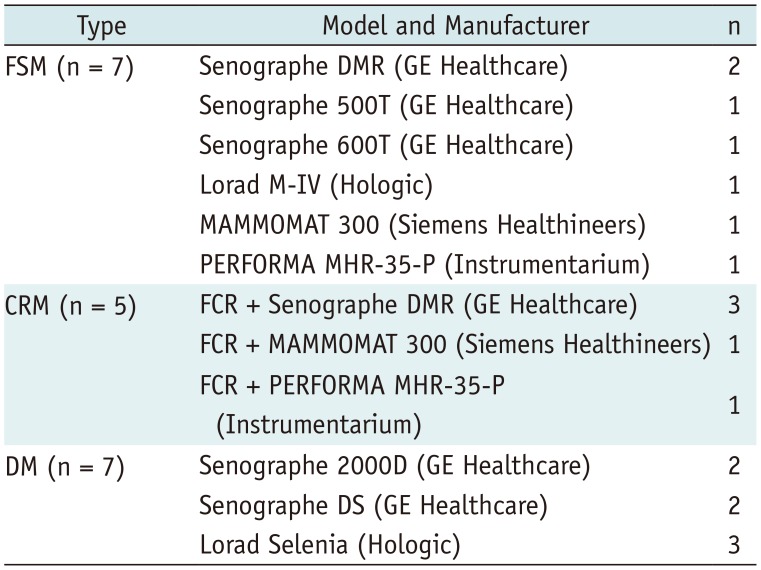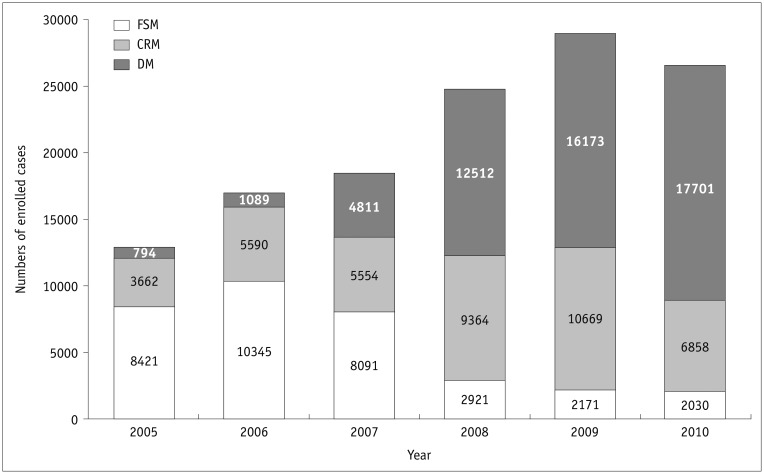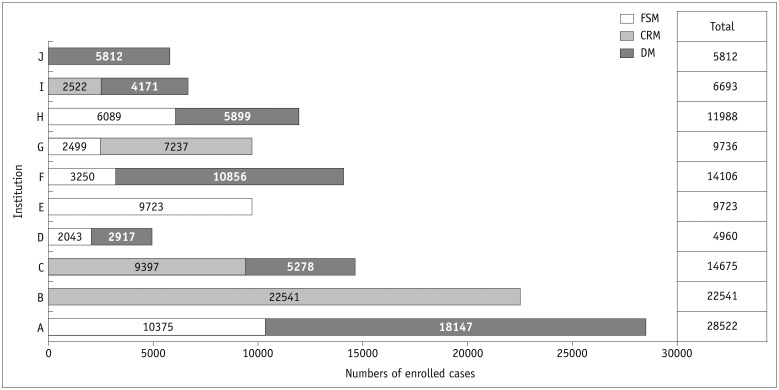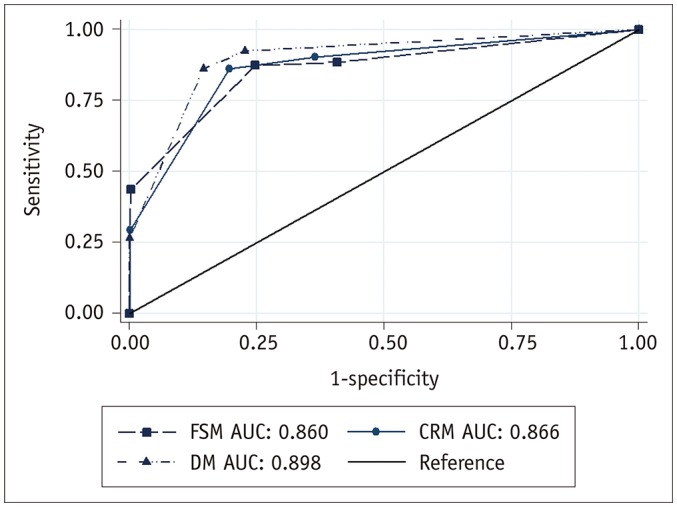1. Jung KW, Won YJ, Oh CM, Kong HJ, Lee DH, Lee KH. Community of Population-Based Regional Cancer Registries. Cancer statistics in Korea: incidence, mortality, survival, and prevalence in 2014. Cancer Res Treat. 2017; 49:292–305. PMID:
28279062.

2. Suh M, Choi KS, Park B, Lee YY, Jun JK, Lee DH, et al. Trends in cancer screening rates among Korean men and women: results of the Korean national cancer screening survey, 2004–2013. Cancer Res Treat. 2016; 48:1–10. PMID:
25943324.

3. Lee EH, Kim KW, Kim YJ, Shin DR, Park YM, Lim HS, et al. Performance of screening mammography: a report of the Alliance for Breast Cancer Screening in Korea. Korean J Radiol. 2016; 17:489–496. PMID:
27390540.

4. Pisano ED, Gatsonis C, Hendrick E, Yaffe M, Baum JK, Acharyya S, et al. Digital Mammographic Imaging Screening Trial (DMIST) Investigators Group. Diagnostic performance of digital versus film mammography for breast-cancer screening. N Engl J Med. 2005; 353:1773–1178. PMID:
16169887.

5. Pisano ED, Hendrick RE, Yaffe MJ, Baum JK, Acharyya S, Cormack JB, et al. DMIST Investigators Group. DMIST Investigators Group. Diagnostic accuracy of digital versus film mammography: exploratory analysis of selected population subgroups in DMIST. Radiology. 2008; 246:376–338. PMID:
18227537.
6. Kerlikowske K, Hubbard RA, Miglioretti DL, Geller BM, Yankaskas BC, Lehman CD, et al. Breast Cancer Surveillance Consortium. Comparative effectiveness of digital versus film-screen mammography in community practice in the United States: a cohort study. Ann Intern Med. 2011; 155:493–450. PMID:
22007043.
7. Timmers JM, den Heeten GJ, Adang EM, Otten JD, Verbeek AL, Broeders MJ. Dutch digital breast cancer screening: implications for breast cancer care. Eur J Public Health. 2012; 22:925–929. PMID:
22158996.

8. Nederend J, Duijm LE, Louwman MW, Groenewoud JH, Donkers-van Rossum AB, Voogd AC. Impact of transition from analog screening mammography to digital screening mammography on screening outcome in the Netherlands: a population-based study. Ann Oncol. 2012; 23:3098–3103. PMID:
22745215.

9. Vigeland E, Klaasen H, Klingen TA, Hofvind S, Skaane P. Full-field digital mammography compared to screen film mammography in the prevalent round of a population-based screening programme: the Vestfold county study. Eur Radiol. 2008; 18:183–191. PMID:
17680246.

10. van Luijt PA, Fracheboud J, Heijnsdijk EA, den Heeten GJ, de Koning HJ. National Evaluation Team for Breast Cancer Screening in Netherlands Study Group (NETB). Nation-wide data on screening performance during the transition to digital mammography: observations in 6 million screens. Eur J Cancer. 2013; 49:3517–3525. PMID:
23871248.

11. Bae JM, Shin SY, Kim EH, Kim YN, Nam CM. Distribution of dense breasts using screening mammography in Korean women: a retrospective observational study. Epidemiol Health. 2014; 36:e2014027. PMID:
25381996.
12. Stomper PC, D'Souza DJ, DiNitto PA, Arredondo MA. Analysis of parenchymal density on mammograms in 1353 women 25–79 years old. AJR Am J Roentgenol. 1996; 167:1261–1265. PMID:
8911192.

13. Mandelson MT, Oestreicher N, Porter PL, White D, Finder CA, Taplin SH, et al. Breast density as a predictor of mammographic detection: comparison of interval- and screen-detected cancers. J Natl Cancer Inst. 2000; 92:1081–1087. PMID:
10880551.

14. Sickles EA, D'Orsi CJ. ACR BI-RADS follow-up and outcome monitoring. In : D'Orsi CJ, Sickles EA, Mendelson EB, Morris EA, editors. ACR BI-RADS® atlas. 5th ed. Reston, VA: American College of Radiology;2013. p. 15–20.
15. DeLong ER, DeLong DM, Clarke-Pearson DL. Comparing the areas under two or more correlated receiver operating characteristic curves: a nonparametric approach. Biometrics. 1988; 44:837–845. PMID:
3203132.

16. Skaane P, Hofvind S, Skjennald A. Randomized trial of screen-film versus full-field digital mammography with soft-copy reading in population-based screening program: follow-up and final results of Oslo II study. Radiology. 2007; 244:708–717. PMID:
17709826.

17. Kim YJ, Lee EH, Jun JK, Shin DR, Park YM, Kim HW, et al. Alliance for Breast Cancer Screening in Korea (ABCS-K). Alliance for Breast Cancer Screening in Korea (ABCS-K). Analysis of participant factors that affect the diagnostic performance of screening mammography: a report of the Alliance for Breast Cancer Screening in Korea. Korean J Radiol. 2017; 18:624–631. PMID:
28670157.
18. Dabbous F, Dolecek TA, Friedewald SM, Tossas-Milligan KY, Macarol T, Summerfelt WT, et al. Performance characteristics of digital vs film screen mammography in community practice. Breast J. 2018; 24:369–372. PMID:
29105900.

19. Karssemeijer N, Bluekens AM, Beijerinck D, Deurenberg JJ, Beekman M, Visser R, et al. Breast cancer screening results 5 years after introduction of digital mammography in a population-based screening program. Radiology. 2009; 253:353–358. PMID:
19703851.

20. Del Turco MR, Mantellini P, Ciatto S, Bonardi R, Martinelli F, Lazzari B, et al. Full-field digital versus screen-film mammography: comparative accuracy in concurrent screening cohorts. AJR Am J Roentgenol. 2007; 189:860–866. PMID:
17885057.

21. Heddson B, Rönnow K, Olsson M, Miller D. Digital versus screen-film mammography: a retrospective comparison in a population-based screening program. Eur J Radiol. 2007; 64:419–425. PMID:
17383841.

22. Dershaw DD, Abramson A, Kinne DW. Ductal carcinoma in situ: mammographic findings and clinical implications. Radiology. 1989; 170:411–415. PMID:
2536185.

23. Duffy SW, Dibden A, Michalopoulos D, Offman J, Parmar D, Jenkins J, et al. Screen detection of ductal carcinoma in situ and subsequent incidence of invasive interval breast cancers: a retrospective population-based study. Lancet Oncol. 2016; 17:109–114. PMID:
26655422.

24. Duffy SW, Tabar L, Vitak B, Day NE, Smith RA, Chen HH, et al. The relative contributions of screen-detected
in situ and invasive breast carcinomas in reducing mortality from the disease. Eur J Cancer. 2003; 39:1755–1760. PMID:
12888371.
25. Kalager M, Zelen M, Langmark F, Adami HO. Effect of screening mammography on breast-cancer mortality in Norway. N Engl J Med. 2010; 363:1203–1210. PMID:
20860502.

26. Welch HG, Prorok PC, O'Malley AJ, Kramer BS. Breast-cancer tumor size, overdiagnosis, and mammography screening effectiveness. N Engl J Med. 2016; 375:1438–1447. PMID:
27732805.








 PDF
PDF ePub
ePub Citation
Citation Print
Print






 XML Download
XML Download